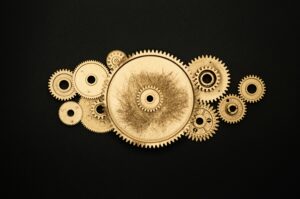Advancements in Aerospace Gear Tech Efficiency & Payload
The Aerospace Industry Benefits Greatly from Advanced Gear Technology In the highly demanding field of aerospace engineering, every component must meet the highest standards of performance and reliability. The Aerospace Industry Benefits Greatly from Advanced Gear Technology, which plays a crucial role in enhancing fuel efficiency and payload capacity. This article explores the significant advancements […]

The Aerospace Industry Benefits Greatly from Advanced Gear Technology
In the highly demanding field of aerospace engineering, every component must meet the highest standards of performance and reliability. The Aerospace Industry Benefits Greatly from Advanced Gear Technology, which plays a crucial role in enhancing fuel efficiency and payload capacity. This article explores the significant advancements in gear technology and their impact on the aerospace sector.
High-Performance Materials
One of the most impactful advancements in gear technology for the aerospace industry is the development and application of high-performance materials. Traditional materials like steel, while strong, are relatively heavy and can limit performance. The introduction of advanced composites and ceramics has revolutionized this aspect of gear technology.
Composites:
Composites such as carbon fiber-reinforced polymers, offer a unique combination of strength and lightness. These materials are much lighter than steel, which directly translates into reduced aircraft weight. This reduction is critical in the aerospace industry, where every kilogram saved can significantly enhance fuel efficiency and increase payload capacity. Composite materials also offer excellent resistance to fatigue and corrosion, further improving the longevity and reliability of aerospace gears.
Ceramics:
Ceramics on the other hand, provide exceptional hardness and resistance to wear. They can operate under high-stress conditions with minimal lubrication, making them ideal for high-temperature environments typically found in aerospace applications. Ceramics also contribute to the overall efficiency of the gears by reducing friction and wear, ensuring smoother operation and longer service life.
Fuel Efficiency and Payload Capacity
Improved Fuel Efficiency
Fuel efficiency is a major concern for aerospace manufacturers and operators. The use of lighter materials in gear construction helps reduce the overall weight of the aircraft. This weight reduction means that less fuel is required to achieve and maintain flight, leading to significant cost savings and reduced environmental impact. In an industry where fuel costs constitute a large portion of operating expenses, these savings are incredibly valuable. Moreover, improving fuel efficiency is critical for meeting increasingly stringent environmental regulations and reducing the carbon footprint of air travel.
Image Courtesy: Pexels
By incorporating advanced materials that contribute to weight reduction, manufacturers can design aircraft that not only perform better but also align with global efforts to combat climate change. The cumulative effect of using advanced materials in gear construction can lead to longer operational ranges, enabling airlines to offer more direct flights with fewer stops, further optimizing fuel use and enhancing overall efficiency.
Increased Payload Capacity
In addition to improving fuel efficiency, lighter gear materials also allow for increased payload capacity. Aircraft can carry more cargo or passengers without exceeding weight limits. This capability is particularly beneficial for commercial airlines and freight carriers, as it allows them to maximize their revenue by transporting more goods or passengers per flight.
For military applications, increased payload capacity translates into the ability to carry more equipment, supplies, or personnel, enhancing mission effectiveness and flexibility. This advantage extends beyond just commercial and military applications; for space exploration and satellite deployment, every kilogram saved in gear weight can be repurposed for additional scientific instruments or payload, significantly enhancing the mission’s scope and potential outcomes.
By integrating lighter gear materials, aerospace engineers can achieve a more efficient distribution of weight, ensuring that the aircraft’s structural integrity and performance are maintained while optimizing load capacity.
Precision Manufacturing Techniques
Advancements in precision manufacturing techniques have been critical in the production of high-quality gears that meet the rigorous demands of the aerospace industry. These techniques ensure that gears are produced with the highest levels of accuracy and consistency, essential for the reliable operation of aerospace systems.
CNC Machining
Computer Numerical Control (CNC) machining is one of the most important precision manufacturing techniques used in gear production. CNC machining allows for the precise cutting and shaping of gears to exact specifications. This level of precision is vital in the aerospace industry, where even minor deviations can lead to significant performance issues.
CNC machining also enables the production of complex gear geometries essential for modern aerospace applications. The ability to program CNC machines for specific tasks ensures that each gear component is produced with consistent quality, reducing the risk of defects and enhancing the overall reliability of aerospace systems.
Furthermore, CNC machining’s automation capabilities streamline the manufacturing process, increasing production efficiency and reducing lead times. This technology also facilitates the customization of gear designs to meet specific requirements, offering flexibility in addressing unique challenges presented by different aerospace applications.
Additive Manufacturing
Additive manufacturing, or 3D printing, has also made significant strides in gear production. This technology allows for the creation of highly complex and lightweight gear designs that would be difficult or impossible to produce using traditional manufacturing methods. Additive manufacturing is particularly useful for rapid prototyping and the production of small, intricate parts.
It also reduces material waste and shortens the production cycle, leading to faster development times and cost savings. The ability to quickly produce and test new gear designs accelerates innovation, allowing engineers to experiment with novel geometries and materials that could further enhance performance.
Additionally, additive manufacturing supports the creation of parts with internal structures optimized for strength and weight, contributing to the overall efficiency of aerospace systems. This technology is not only revolutionizing gear production but also opening new possibilities for the design and functionality of aerospace components, pushing the boundaries of what is possible in the industry.
Advanced Design Tools
The design and analysis of aerospace gears have been greatly enhanced by the use of advanced design tools. These tools enable engineers to simulate and optimize gear performance before physical production, ensuring that the final products meet all performance requirements.
Finite Element Analysis (FEA)
Finite Element Analysis (FEA) is a powerful tool used to predict how gears will perform under various conditions. By breaking down a gear into smaller elements, FEA allows engineers to analyze stress, strain, and deformation in great detail.
This insight helps in designing gears that can withstand the high loads and harsh environments typical of aerospace applications. FEA is essential for identifying potential issues and making necessary adjustments to improve gear performance and reliability. The ability to model and test different scenarios virtually reduces the need for extensive physical testing, saving time and resources.
FEA also allows for the optimization of material usage, ensuring that each gear component is designed to achieve maximum efficiency with minimal weight. By incorporating FEA into the design process, engineers can develop gears that are both robust and lightweight, meeting the demanding requirements of aerospace applications while pushing the boundaries of engineering innovation.
Gear Dynamics Simulation
Gear dynamics simulation software models the behavior of gears in real-time, considering factors such as load distribution, vibration, and noise. These simulations are crucial for optimizing gear designs to ensure smooth operation and minimize wear and tear.
By using these advanced tools, engineers can create gears that operate more quietly and efficiently, enhancing the overall performance of aerospace systems. The insights gained from gear dynamics simulations enable the fine-tuning of gear interactions, reducing the risk of excessive wear and potential failure.
This proactive approach to design and testing ensures that the gears can handle the dynamic and often unpredictable conditions encountered during flight, thereby improving reliability and extending the service life of aerospace components. Additionally, gear dynamics simulations help in identifying potential sources of noise and vibration, which can be mitigated through design adjustments, resulting in quieter and more comfortable aircraft.
Extreme Flight Conditions
Gears used in the aerospace industry must endure extreme flight conditions, including high loads, temperatures, and speeds. The advancements in materials, manufacturing techniques, and design tools collectively ensure that aerospace gears can meet these rigorous demands.
High Loads
Aerospace gears must handle high loads, particularly during takeoff, landing, and turbulent flight conditions. The strength and durability of high-performance materials like composites and ceramics ensure that gears can withstand these stresses without failure. Precision manufacturing ensures that gears fit perfectly and operate smoothly, distributing loads evenly and reducing the risk of mechanical failure.
The ability to withstand high loads is crucial for maintaining the structural integrity and functionality of aircraft, especially in demanding scenarios such as emergency maneuvers or heavy-lift operations. By utilizing advanced materials and precision engineering techniques, aerospace engineers can develop gears that maintain their integrity and performance even under the most extreme conditions. This capability is essential for ensuring the safety and reliability of aircraft, especially in critical moments where gear performance can significantly impact the outcome of the flight.
High Temperatures
Aerospace gears often operate in high-temperature environments, especially in jet engines and other propulsion systems. Ceramic materials are particularly well-suited for these conditions due to their excellent heat resistance. Advanced coatings and surface treatments can further enhance the heat tolerance of gears, ensuring reliable performance even under extreme thermal conditions.
The ability to maintain functionality at high temperatures is essential for the efficiency and longevity of aerospace gears, particularly in components exposed to the intense heat generated by high-speed flight and combustion processes. By utilizing materials and treatments that can withstand these extreme conditions, aerospace engineers can design gears that deliver consistent performance and reliability throughout the aircraft’s operational life.
This capability is crucial for optimizing the performance of propulsion systems and other high-temperature applications, ensuring that gears contribute to the overall efficiency and safety of the aircraft.
The Aerospace Industry Benefits Greatly from Advanced Gear Technology continues to thrive as significant advancements in materials, manufacturing techniques, and design tools enhance the performance and reliability of aerospace systems. The use of high-performance materials such as composites and ceramics leads to substantial reductions in aircraft weight, improving both fuel efficiency and payload capacity.
Precision manufacturing techniques like CNC machining and additive manufacturing ensure that gears meet the highest standards of accuracy and quality. Advanced design tools enable the optimization of gear performance, ensuring reliability under extreme flight conditions. As technology progresses, further improvements in gear technology will enhance the capabilities and efficiency of aerospace systems.
These innovations will continue to play a critical role in the evolution of the aerospace industry, driving progress and enabling new possibilities in air travel and beyond. The ongoing development and integration of advanced gear technologies promise to set new benchmarks for performance, safety, and sustainability in the aerospace sector, ensuring that future generations of aircraft are more efficient, capable, and environmentally friendly than ever before.


